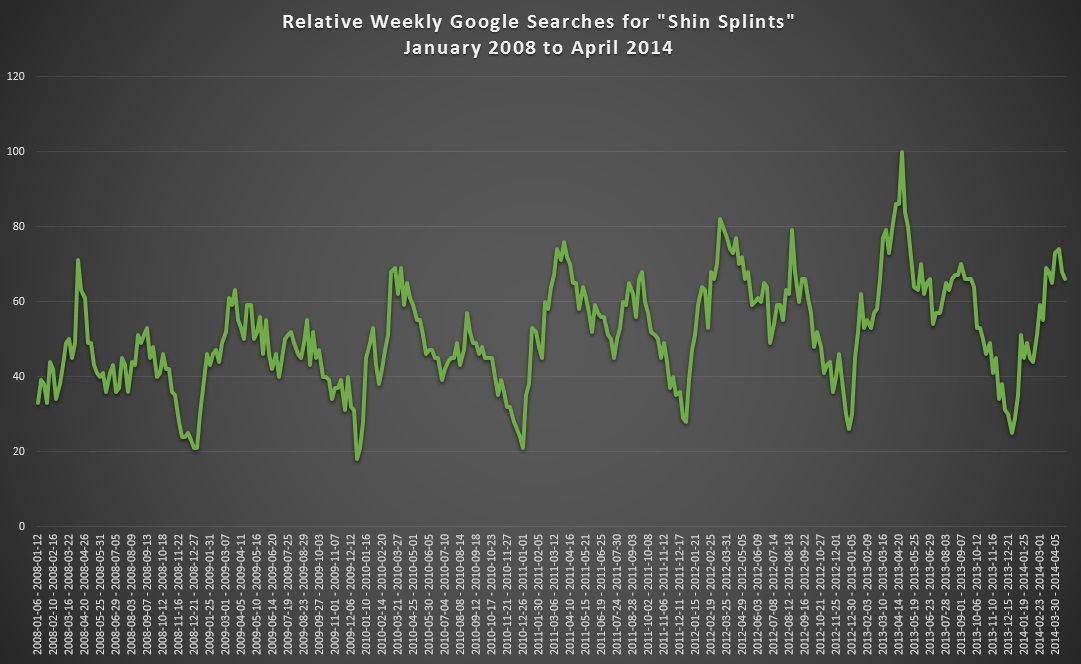Why Shin Splints Soar in April

Every year around March and April, the number of people searching online for information about shin splints reaches a peak, the data from Google show. Doctors say the yearly pattern is also visible in the increased number of people coming to their office with pain in the lower legs, or shin splints, during these first weeks of spring.
"We see more people in early spring than we do any other time of the year," said Dr. Matthew Silvis, a family medicine and sports medicine physician at Penn State Hershey Medical Center.
But what are shin splints, and why do they peak in March and April?
Shin splints are one of the most common exercise injuries, and are typically seen in runners. But people may use the term as a general phrase to describe a variety of painful conditions that affects the front portion of their legs, said Lynn Millar, professor of physical therapy at Winston-Salem State University in North Carolina, and a member of the American College of Sports Medicine.
"There are different compartments around the shin, so there can actually be different problems there with a slightly different cause," Millar said. [7 Common Exercise Errors And How to Fix Them]
Most commonly, shin splints refer to soreness and pain along the shinbone (tibia), which is the large bone in the lower leg. The actual medical term is medial tibial stress syndrome. It is caused by inflammation of the outer layer of the bone due to overuse of the muscles and tendons around the shin.
Doctors say the number of people getting shin splints soars in April most likely because of a sudden increase in activity after a dormant winter.
Get the world’s most fascinating discoveries delivered straight to your inbox.
"A lot of people weren't outside running on the pavement in the winter. When the weather starts to get nice, people get excited and start running again, and they just haven't been doing it for a while," Silvis said.
"When people do too much too quickly, it causes a lot of stress on that bone and the bone responds by becoming inflamed and sore," he said.
Part of the trend is also driven by the start of track and field season. "You would see shin splints around this time of year with high school track athletes," Millar said.
In fact, even those people who have been active during the winter, but were exercising indoors, may get shin splints if they try running as hard outside, said Dr. Michael Gleiber, a spine surgeon in Jupiter, Florida, and a spokesperson for the American Academy of Orthopaedic Surgeons.
"Any sudden change can create a problem. Whether it's a modification in the setting or intensity of exercise, we have to gradually allow our body to adapt," Gleiber said. "If we are used to running a mile, my advice is to cut that in half when we start outside, and slowly increase."
Treating shin splints
Shin splints usually heal on their own, and most people can get better without having to see a doctor, Gleiber said.
The treatment for a shin splint includes resting the body and putting ice on the area, as well as taking anti-inflammatory medication to relieve the pain. People should wait until they are pain-free for about two weeks before they return to running, he said.
For people who get shin splints every time they exercise, the doctors recommend visiting a health practitioner who can look for what is causing the problem, such as improper alignment while running, flat feet or not wearing proper shoes that provide good support.
If shin splints are not treated they can lead to stress fractures, or tiny cracks in the bone. If the pain is in one spot and worsens with touch, and it doesn't go away, it may be a sign of a fracture, doctors said.
"A lot of people feel aches and pains whenever they run, but those pains and aches that persist in the next days — that's something they should pay attention to," Silvis said.
How to prevent shin splints
To prevent getting shin splints, the doctors' advice is to start or ramp up exercise routines slowly and progressively.
"People shouldn't increase their running [distance or duration] more than 10 percent in a week," Silvis said.
Stretching and warming up before running are important steps to prevent shin splints, doctors said. This may be especially important for people who tend to wear high heels all day, Millar said.
"They should make sure to do a really good warm-up before training and that would include stretches," she said.
People should also check their shoes and make sure they still provide the support their body needs.
"The beginning of spring is also a good time to replace your shoes. If your shoes are really worn down, that can contribute to all sort of problems in lower extremities," Millar said. Typically, doctors recommend changing shoes every four to six months, or every 300 to 500 miles.
Another thing people can do to reduce the risk of getting shin splints is to balance their training and cross train with other activities — such as swimming, cycling and yoga — that don't stress the shinbone as much, Millar said.
Flexibility exercises that ensure the leg muscles are not tight can also help, Millar said.
Strengthening all muscles, including the core and hip muscles, is also important.
"A lot of runners think they are strong, and they are, but there are certain muscles you don't really use when you're running, it's important to have those muscles be developed because they can prevent injuries," Silvis said.
Email Bahar Gholipour. Follow us @LiveScience, Facebook & Google+. Original article on Live Science.




